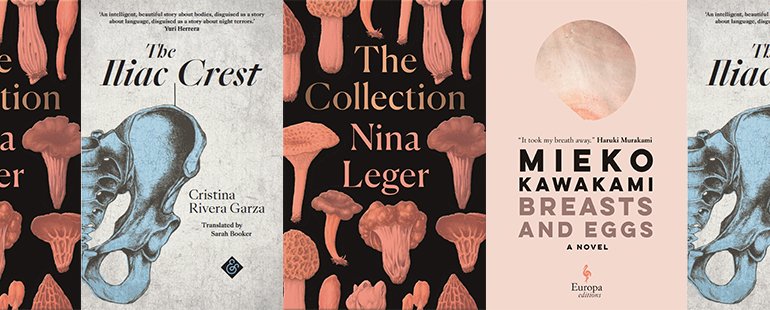Gender and the Body in Breasts and Eggs, The Collection, and The Iliac Crest

“Her body was young, soft, lovely, the breasts like small birds in flight, her ass like a flower.” I’ll never forget this line from Bernard Malamud—it made me let out an undignified snort in the middle of a solemn graduate reading seminar. The scene, from Malamud’s The Assistant (1957), is written from the perspective of a boy looking through a window at a woman as she steps out of her housecoat. Poor Helen Bober didn’t know Frank was watching her; she didn’t know he was constructing juvenile similes out of her body parts. In novels, women’s bodies are refracted through the prism of the culture in which the narratives are written. Breasts are turned into animals, skin into confectionery, asses into bouquets, curves into threats, thighs into rage, and spines into desire. It’s always a relief, then, to take the mic from the boy at the window, and pass it back to the woman he’s spying on.
Around the world, woman novelists are refocusing literary narratives about desire, sex, and the body around their own experiences; some of these narratives explore society’s current hang-ups around women’s bodies, some paint a picture of a potential world full of guilt-free pleasure, and some explode the idea of gender determined by the body. Mieko Kawakami’s Breasts and Eggs (2008), translated into English from the original Japanese by Sam Bett and David Boyd last year, for example, reflects sexual and societal pressures faced by Japanese women. As she writes from their point of view, Kawakami takes an unsentimental view of women’s bodies, of motherhood, and of the gendered basis of societal expectations.
The book centers its action on three women—Natsu, her sister Makiko, and her niece Midoriko. Natsu explores the option of using a sperm bank to become pregnant as a single woman, Makiko travels to Tokyo for breast implant surgery, and Midoriko becomes mute in response to her body changing as she enters adolescence. In one emblematic conversation, two of these three women talk about their mothers’ lives:
‘My mom never hit me or anything. She raised me well enough, and I still hated her.’
‘For no reason?’
‘For every reason.’ Rie emptied her sake cup. ‘Let’s start off with how she saw my dad. He was your typical king of the kill . . . I was a kid, and a girl on top of that, so he never saw me as a real person. I never even heard him call my mother by her name. It was always Hey you. We were constantly on red alert because my dad would beat the shit out of us or break things for no reason . . . Yeah, my mom was free labor—free labor with a pussy.’
The mother under discussion here is almost de-sexualized, even as her sexual organ is called out for its usefulness to the household—the mother’s pussy might as well be a mop. This sort of commodification of women’s bodies is at the heart of Kawakami’s inventive novel. Through her characters’ specific struggles with their breasts and wombs, Kawakami shows the reader how a woman’s body is used to fuel the capitalist machine of Japanese society—women are expected to take care of men, bear children, and buy goods and services to stay sexy for life. The American reader is likely to recognize these pressures and to sympathize with how Kawakami’s characters come to view themselves not as whole, individual women, but as an assembly of economically useful body parts.
Throughout the second part of the novel, Natsu, an accomplished writer and single woman, wrestles with her desire to have a child. She doesn’t have a man in her life, but she can get pregnant with the help of a Scandinavian sperm bank. Natsu is worried, however, about the moral implications of having a child alone. She is worried that the child will be outcast for being fatherless, and she is worried that she won’t be a good enough mother. In one scene, she looks in the mirror, and she turns the unsentimental gaze upon herself:
I looked awful. My poor neglected hair was dull and scraggly, and my eyebrows were perfectly crooked. I was wearing foundation, but it was streaky and patchy, which defeated the point of wearing foundation at all. . . . My complexion was horrendous, and my face was lifeless. I reminded myself of a pickled eggplant. Not the skin, but the greenish flesh inside. How could the dried-up, worn-out woman staring back at me be the source of a new life?
Here, Kawakami explores a particular kind of culturally-inflected disassociation between what Natsu’s body looks like and what it’s supposed to look like in order to fulfill its feminine potential; Kawakami shows us how intimately a woman’s physical appearance is connected with her perceived ability to reproduce and nurture. Under a capitalistic system that requires immense effort with the appearance of ease, Natsu is failing to both work hard and to have that work be invisible on her body. The demands of her culture are so pervasive and intense that no other character needs to tell Natsu what to feel bad about—she has turned society’s gaze inward and uses it to judge herself.
While readers will relate to and sympathize with Kawakami’s characters and their critical self-evaluations—who hasn’t frowned in front of a mirror?—imagine a story about a woman having sex without a single description of that woman’s body. Nina Leger’s The Collection (2017), translated into English from the original French by Laura Francis in 2019, presents a potential world free of body judgment. The reader has no idea what Jeanne’s breasts or ass look like, though we watch her have anonymous sex with a series of different men. Jeanne books the hotel rooms and controls the sex scenes.
The Collection is written in an intense present that excludes anxiety, second-guessing, and self-critical thinking. Jeanne has sex without worrying if she is a moral woman. She meets men and offers herself to them without first “preparing” her body to be seen and consumed. Who Jeanne is isn’t important—the only thing that matters is what she does; likewise, the men as characters aren’t important here, except for one particular body part:
Her gestures are slow, diligent. She passes the penis between her fingers, into her mouth, presses it against her face. She examines it, occasionally putting it to her ear to listen to the blood beating, follows the curve of the head with her thumb, feels for the slit which drinks up her saliva.
She isolates the penis between her two cupped hands, excludes the body, and fixates upon the mobility of the organ that gradually fills out the space. The furniture diminishes, the details blanch out. She remains alone with the penis which she has made her own. Even her own body has lost substance.
This passage is one among many that is likely to surprise the North American reader, who is used to women who enjoy sex being punished by narrative. In The Collection, nothing bad happens to Jeanne, no one judges her, and she isn’t wrestling with any inner demons—and the absence of self-flagellation in this slim book makes us examine why we expected any. Why shouldn’t a woman look through a window and cut away everything from a man except for the body part that interests her? What does it say about our culture that Jeanne’s worry-free sex life bucks our expectations so profoundly? By the end of the novel, the reader is left to imagine that Jeanne will continue as she is: a woman who knows what she likes, who gets it when she wants, and who won’t be punished by society or narrative for curating her collection.
Cristina Rivera Garza’s The Iliac Crest (2002), translated into English from the original Spanish by Sarah Booker in 2017, also dismantles the reader’s expectations of how sex and gender are written in narrative. The iliac crest is the largest bone in the pelvis, and its relative height and width distinguish a male skeleton from a female skeleton. This bone is the first thing that the narrator, a man doctor consigned to a seaside hospice, notices about the woman who comes to call unexpectedly one dark and stormy night. At first, the narrator says: “[W]hat really captured my attention was her right hip bone, which, because of the way she was leaning against the doorframe and the weight of the water over her skirt’s faded flowers, could be glimpsed just below the unfinished hem of her T-shirt and just above the elastic of her waistband. . . . I wanted her.” Then, at the start of the next chapter, the narrator revises his first impression of his unexpected visitor: “But when I noticed her hip bone—the one peeking out from under the unfinished hem of her T-shirt and just above the elastic of her flowered skirt, . . . I did not feel desire, but fear.” This realization, that the narrator has confused a spark of desire with a shiver of fear, is a signal to the reader that emotions, body parts, symbols, and expectations are going to be confused, muddled, and dismantled throughout the book. Our protagonist’s home is soon after invaded by two women, who build their own world and even create their own language inside the doctor’s home, excluding him from their feminine universe all while claiming to know his biggest secret—that he is really a woman.
The doctor, despite frequently checking to make sure his penis is still in place, is plunged into panic and confusion over the possibility that his uninvited houseguests may be right. Within this chaos, Rivera Garza takes aim at anatomy as the defining criteria for gender identity. Despite the position of his iliac crest, the doctor may be a woman after all. Without the comforting binary of biology, how can we construct gender and the expectations and consequences of gender in culture? Rivera Garza moves beyond Kawakami’s reflection of current societal pressures and Leger’s vision of guilt-free desire to write the body as a changeable construct of culture.
Kawakami, Leger, and Rivera Garza, in different ways, take the mic away from the man at the window watching a woman undress. Kawakami reorients the narrative around how society’s expectations of women’s bodies cause them to commodify and evaluate themselves. The reader is likely to see herself in Kawakami’s characters, and to reevaluate the harsh pressures she puts on her own body. Leger imagines an urgent present defined by actions instead of appearances, which forces the reader to examine their own expectations of sex and consequences in narrative. Rivera Garza writes past the body as a discrete entity fixed in space and time to posit that all bodies are reflections of the cultures in which they exist. In this way, Garza explodes the biological imperatives of narrative. She turns Helen Bober around and stares, appraisingly, at Frank through the window.
This piece was originally published on July 29, 2021.


